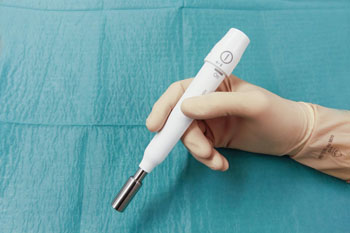Wireless Probe Detects Cancer Cells During Surgery
|
By HospiMedica International staff writers Posted on 23 Jun 2016 |

Image: The EPFL Beta probe (Photo courtesy of EPFL).
Novel wireless probes inserted into the surgical wound identify cancer cells and suspicious lymph nodes by emitting an auditory alarm that directs the surgeon.
Developed by researchers at Ecole Polytechnique Fédérale de Lausanne (EPFL; Switzerland), the Gamma and Beta probes are 20 centimeters long each and weigh around 100 grams, resembling a large pen. While the Gamma probe is an upgrade to similar devices already used, the Beta probe is a completely new device that is able to detect extremely small specimens of cancerous tissue by searching for positrons emitted by a tracer substance, which attaches to the cancer cells. Since positrons can only travel through a millimeter of tissue, when detected they pinpoint the tumor cells.
The Gamma probe does not directly detect cancer cells; instead, it finds a sentinel lymph node--the lymph node cancer cells reach before they make their way to the rest of the body--near the main tumor site. The lymph node can then be removed by the surgeons and used to stage the disease. If the sentinel lymph node is free of cancer cells, it means that the tumor has not spread. Both probes were tested at University Hospital Lausanne (CHUV; Switzerland), after earning the European CE mark in early 2015.
“The probe has a little window at one end that picks up the gamma rays or positrons given off by the substance injected into the patient,” said Edoardo Charbon, director of the Advanced Quantum Architecture Lab (AQUA) at EPFL. “A scintillator converts the energy of the rays into photons, which are then detected by a highly sensitive sensor.”
The positron is the antimatter counterpart of the electron; it has an electric charge of +1 e, a spin of ½, and has the same mass as an electron. When a low-energy positron collides with a low-energy electron, annihilation occurs, resulting in the production of two or more gamma ray photons. Positrons may be generated by positron emission radioactive decay (through weak interactions), or by pair production from a sufficiently energetic photon, which is interacting with an atom in a material.
Related Links:
Ecole Polytechnique Fédérale de Lausanne
University Hospital Lausanne
Developed by researchers at Ecole Polytechnique Fédérale de Lausanne (EPFL; Switzerland), the Gamma and Beta probes are 20 centimeters long each and weigh around 100 grams, resembling a large pen. While the Gamma probe is an upgrade to similar devices already used, the Beta probe is a completely new device that is able to detect extremely small specimens of cancerous tissue by searching for positrons emitted by a tracer substance, which attaches to the cancer cells. Since positrons can only travel through a millimeter of tissue, when detected they pinpoint the tumor cells.
The Gamma probe does not directly detect cancer cells; instead, it finds a sentinel lymph node--the lymph node cancer cells reach before they make their way to the rest of the body--near the main tumor site. The lymph node can then be removed by the surgeons and used to stage the disease. If the sentinel lymph node is free of cancer cells, it means that the tumor has not spread. Both probes were tested at University Hospital Lausanne (CHUV; Switzerland), after earning the European CE mark in early 2015.
“The probe has a little window at one end that picks up the gamma rays or positrons given off by the substance injected into the patient,” said Edoardo Charbon, director of the Advanced Quantum Architecture Lab (AQUA) at EPFL. “A scintillator converts the energy of the rays into photons, which are then detected by a highly sensitive sensor.”
The positron is the antimatter counterpart of the electron; it has an electric charge of +1 e, a spin of ½, and has the same mass as an electron. When a low-energy positron collides with a low-energy electron, annihilation occurs, resulting in the production of two or more gamma ray photons. Positrons may be generated by positron emission radioactive decay (through weak interactions), or by pair production from a sufficiently energetic photon, which is interacting with an atom in a material.
Related Links:
Ecole Polytechnique Fédérale de Lausanne
University Hospital Lausanne
Latest Surgical Techniques News
- DNA Origami Improves Imaging of Dense Pancreatic Tissue for Cancer Detection and Treatment
- Pioneering Sutureless Coronary Bypass Technology to Eliminate Open-Chest Procedures
- Intravascular Imaging for Guiding Stent Implantation Ensures Safer Stenting Procedures
- World's First AI Surgical Guidance Platform Allows Surgeons to Measure Success in Real-Time
- AI-Generated Synthetic Scarred Hearts Aid Atrial Fibrillation Treatment
- New Class of Bioadhesives to Connect Human Tissues to Long-Term Medical Implants
- New Transcatheter Valve Found Safe and Effective for Treating Aortic Regurgitation
- Minimally Invasive Valve Repair Reduces Hospitalizations in Severe Tricuspid Regurgitation Patients
- Tiny Robotic Tools Powered by Magnetic Fields to Enable Minimally Invasive Brain Surgery
- Magnetic Tweezers Make Robotic Surgery Safer and More Precise
- AI-Powered Surgical Planning Tool Improves Pre-Op Planning
- Novel Sensing System Restores Missing Sense of Touch in Minimally Invasive Surgery
- Headset-Based AR Navigation System Improves EVD Placement
- Higher Electrode Density Improves Epilepsy Surgery by Pinpointing Where Seizures Begin
- Open-Source Tool Optimizes Placement of Visual Brain Implants
- Easy-To-Apply Gel Could Prevent Formation of Post-Surgical Abdominal Adhesions
Channels
Critical Care
view channel
Breakthrough AI Technology Accurately Assesses Heart Failure Severity
Heart failure (HF) is a complex condition where the heart cannot effectively pump blood to meet the body’s needs due to underlying medical issues. It is marked by recurring episodes and frequent hospitalizations.... Read more
New Approach to Visualizing Blood Pressure Data Can Help Better Manage Hypertension Patients
Sometimes, a patient’s blood pressure may be elevated in a doctor's office but normal at home, a phenomenon known as white coat hypertension. It is estimated that 10% to 20% of high blood pressure diagnoses... Read morePatient Care
view channel
Portable Biosensor Platform to Reduce Hospital-Acquired Infections
Approximately 4 million patients in the European Union acquire healthcare-associated infections (HAIs) or nosocomial infections each year, with around 37,000 deaths directly resulting from these infections,... Read moreFirst-Of-Its-Kind Portable Germicidal Light Technology Disinfects High-Touch Clinical Surfaces in Seconds
Reducing healthcare-acquired infections (HAIs) remains a pressing issue within global healthcare systems. In the United States alone, 1.7 million patients contract HAIs annually, leading to approximately... Read more
Surgical Capacity Optimization Solution Helps Hospitals Boost OR Utilization
An innovative solution has the capability to transform surgical capacity utilization by targeting the root cause of surgical block time inefficiencies. Fujitsu Limited’s (Tokyo, Japan) Surgical Capacity... Read more
Game-Changing Innovation in Surgical Instrument Sterilization Significantly Improves OR Throughput
A groundbreaking innovation enables hospitals to significantly improve instrument processing time and throughput in operating rooms (ORs) and sterile processing departments. Turbett Surgical, Inc.... Read moreHealth IT
view channel
Printable Molecule-Selective Nanoparticles Enable Mass Production of Wearable Biosensors
The future of medicine is likely to focus on the personalization of healthcare—understanding exactly what an individual requires and delivering the appropriate combination of nutrients, metabolites, and... Read more
Smartwatches Could Detect Congestive Heart Failure
Diagnosing congestive heart failure (CHF) typically requires expensive and time-consuming imaging techniques like echocardiography, also known as cardiac ultrasound. Previously, detecting CHF by analyzing... Read moreBusiness
view channel
Expanded Collaboration to Transform OR Technology Through AI and Automation
The expansion of an existing collaboration between three leading companies aims to develop artificial intelligence (AI)-driven solutions for smart operating rooms with sophisticated monitoring and automation.... Read more

















